人教版九年级上册英语导学案--Unit 8
九年级英语全册 Unit 8 It must belong to Carla导学案 (新版)人教新目标版
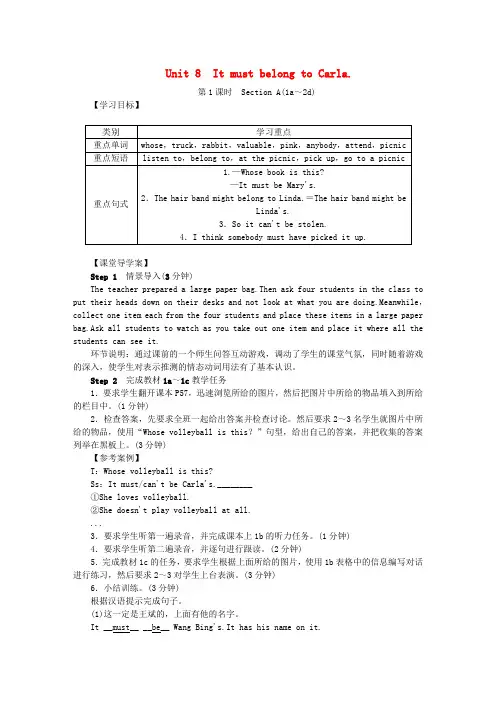
Unit 8 It must belong to Carla.第1课时Section A(1a~2d)【学习目标】【课堂导学案】Step 1情景导入(3分钟)The teacher prepared a large paper bag.Then ask four students in the class to put their heads down on their desks and not look at what you are doing.Meanwhile,collect one item each from the four students and place these items in a large paper bag.Ask all students to watch as you take out one item and place it where all the students can see it.环节说明:通过课前的一个师生问答互动游戏,调动了学生的课堂气氛,同时随着游戏的深入,使学生对表示推测的情态动词用法有了基本认识。
Step 2完成教材1a~1c教学任务1.要求学生翻开课本P57,迅速浏览所给的图片,然后把图片中所给的物品填入到所给的栏目中。
(1分钟)2.检查答案,先要求全班一起给出答案并检查讨论。
然后要求2~3名学生就图片中所给的物品,使用“Whose volleyball is this?”句型,给出自己的答案,并把收集的答案列举在黑板上。
(3分钟)【参考案例】T:Whose volleyball is this?Ss:It must/can't be Carla's.________①She loves volleyball.②She doesn't play volleyball at all....3.要求学生听第一遍录音,并完成课本上1b的听力任务。
新人教版九年级英语unit8导学案
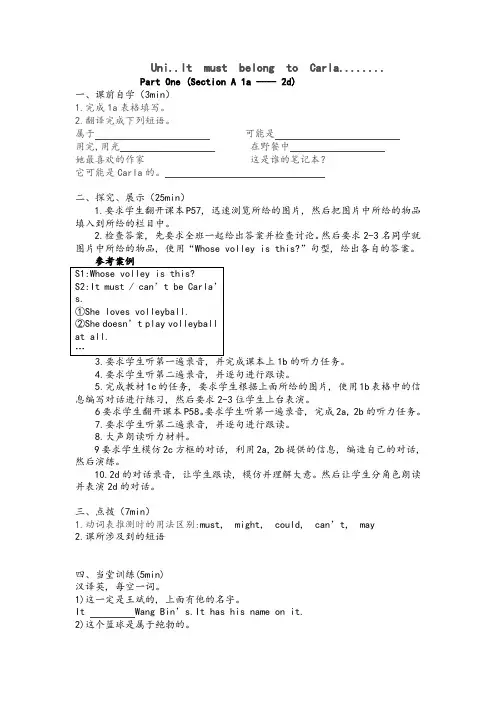
Uni..It must belong to Carla........Part One (Section A 1a ---- 2d)一、课前自学(3min)1.完成1a表格填写。
2.翻译完成下列短语。
属于可能是用完,用光在野餐中她最喜欢的作家这是谁的笔记本?它可能是Carla的。
二、探究、展示(25min)1.要求学生翻开课本P57, 迅速浏览所给的图片, 然后把图片中所给的物品填入到所给的栏目中。
2.检查答案, 先要求全班一起给出答案并检查讨论。
然后要求2-3名同学就图片中所给的物品, 使用“Whose volley is this?”句型, 给出各自的答案。
1b的听力任务。
4.要求学生听第二遍录音, 并逐句进行跟读。
5.完成教材1c的任务, 要求学生根据上面所给的图片, 使用1b表格中的信息编写对话进行练习, 然后要求2-3位学生上台表演。
6要求学生翻开课本P58。
要求学生听第一遍录音, 完成2a, 2b的听力任务。
7.要求学生听第二遍录音, 并逐句进行跟读。
8.大声朗读听力材料。
9要求学生模仿2c方框的对话, 利用2a, 2b提供的信息, 编造自己的对话, 然后演练。
10.2d的对话录音, 让学生跟读, 模仿并理解大意。
然后让学生分角色朗读并表演2d的对话。
三、点拨(7min)1.动词表推测时的用法区别:must, might, could, can’t, may2.课所涉及到的短语四、当堂训练(5min)汉译英, 每空一词。
1)这一定是王斌的, 上面有他的名字。
It Wang Bin’s.It has his name on it.2)这个篮球是属于鲍勃的。
The basketball3)你听古典音乐吗?Do you listen to4)这是谁的自行车?is this?( )1 —Let’s go to the market by taxi. —We___ take a taxi. It is not too far from here.. A.can’t . B.needn’t ..C.couldn’t . D.mustn’t( )2 “May I try on the jeans?”“Yes, you_____”A. should .B.can .C.must .D.need( )3 When traffic lights are red, we ___stop and wait.A. may ..B. can .C.must .D.mightPart Two (Section A 3a—3c)一、课前自学(3min)翻译完成下列短语。
人教版九年级英语上册第八单元导学案
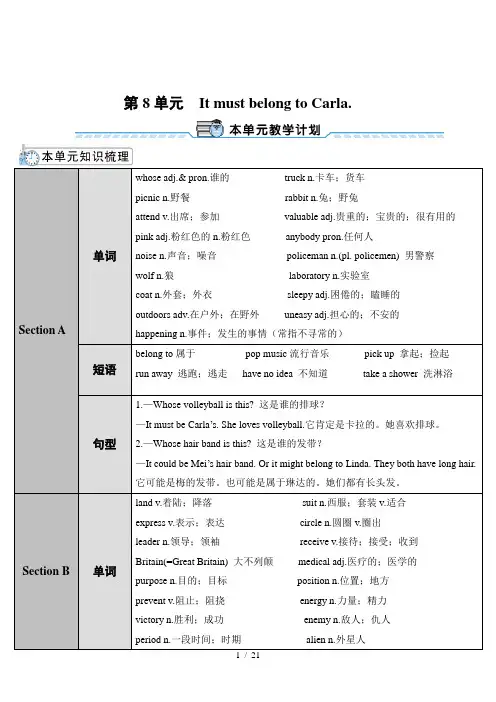
第8单元It must belong to Carla.Section A 单词whose adj.& pron.谁的truck n.卡车;货车picnic n.野餐rabbit n.兔;野兔attend v.出席;参加valuable adj.贵重的;宝贵的;很有用的pink adj.粉红色的n.粉红色anybody pron.任何人noise n.声音;噪音policeman n.(pl. policemen) 男警察wolf n.狼laboratory n.实验室coat n.外套;外衣sleepy adj.困倦的;瞌睡的outdoors adv.在户外;在野外uneasy adj.担心的;不安的happening n.事件;发生的事情(常指不寻常的)短语belong to属于pop music流行音乐pick up 拿起;捡起run away 逃跑;逃走have no idea 不知道take a shower 洗淋浴句型1.—Whose volleyball is this? 这是谁的排球?—It must be Carla’s. She loves volleyball.它肯定是卡拉的。
她喜欢排球。
2.—Whose hair band is this? 这是谁的发带?—It could be Mei’s hair band. Or it might belong to Linda. They both have long hair.它可能是梅的发带。
也可能是属于琳达的。
她们都有长头发。
Section B 单词land v.着陆;降落suit n.西服;套装v.适合express v.表示;表达circle n.圆圈v.圈出leader n.领导;领袖receive v.接待;接受;收到Britain(=Great Britain) 大不列颠medical adj.医疗的;医学的purpose n.目的;目标position n.位置;地方prevent v.阻止;阻挠energy n.力量;精力victory n.胜利;成功enemy n.敌人;仇人period n.一段时间;时期alien n.外星人mystery n.奥秘;神秘事物ancestor n.祖宗;祖先midsummer n.仲夏;中夏burial n.埋葬;安葬historian n.历史学家;史学工作者honor(=honour)v.尊重;表示敬意n.荣幸;荣誉短语run after 追逐;追赶at the same time 同时;一起point out 指出;指明prevent sb.from doing sth.阻止某人做某事a long period of time 很长一段时间communicate with sb.与某人交流/练习in a certain way以某种方式句型1. People like to go to this place especially in June as they want to see the sun rising on the longest day of the year.人们尤其喜欢在六月去这个地方,因为他们想在一年中最长的一天看日出。
Unit8ItmustbelongtoCarla.导学案人教版英语九年级全册
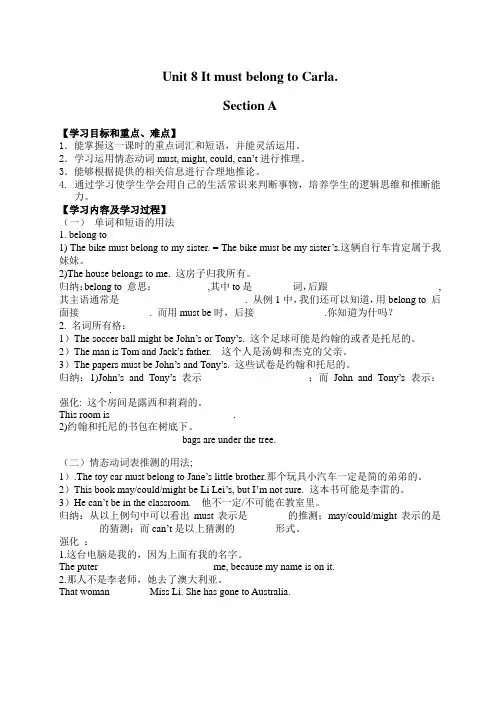
Unit 8 It must belong to Carla.Section A【学习目标和重点、难点】1.能掌握这一课时的重点词汇和短语,并能灵活运用。
2.学习运用情态动词must, might, could, can’t进行推理。
3.能够根据提供的相关信息进行合理地推论。
4. 通过学习使学生学会用自己的生活常识来判断事物,培养学生的逻辑思维和推断能力。
【学习内容及学习过程】(一)单词和短语的用法1. belong to1) The bike must belong to my sister. = The bike must be my sister’s.这辆自行车肯定属于我妹妹。
2)The house belongs to me. 这房子归我所有。
归纳:belong to 意思:___________,其中to是________词,后跟______________________, 其主语通常是_________________________. 从例1中,我们还可以知道,用belong to 后面接______________. 而用must be时,后接______________.你知道为什吗?2. 名词所有格:1)The soccer ball might be John’s or Tony’s. 这个足球可能是约翰的或者是托尼的。
2)The man is Tom and Jack’s father. 这个人是汤姆和杰克的父亲。
3)The papers must be John’s and Tony’s. 这些试卷是约翰和托尼的。
归纳:1)John’s and Tony’s 表示_____________________;而John and Tony’s表示:__________.强化: 这个房间是露西和莉莉的。
This room is ________ ________ _______.2)约翰和托尼的书包在树底下。
【最新】人教版九年级英语Unit8 导学案
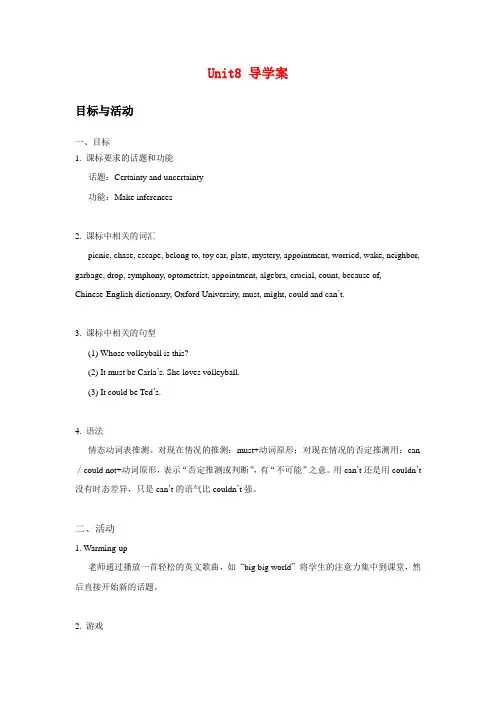
Unit8 导学案目标与活动一、目标1. 课标要求的话题和功能话题:Certainty and uncertainty功能:Make inferences2. 课标中相关的词汇picnic, chase, escape, belong to, toy car, plate, mystery, appointment, worried, wake, neighbor, garbage, drop, symphony, optometrist, appointment, algebra, crucial, count, because of, Chinese-English dictionary, Oxford University, must, might, could and can’t.3. 课标中相关的句型(1) Whose volleyball is this?(2) It must be Carla’s. She loves volleyball.(3) It could be Ted’s.4. 语法情态动词表推测。
对现在情况的推测:must+动词原形;对现在情况的否定推测用:can /could not+动词原形,表示“否定推测或判断”,有“不可能”之意。
用can’t还是用couldn’t 没有时态差异,只是can’t的语气比couldn’t强。
二、活动1. Warming-up老师通过播放一首轻松的英文歌曲,如“big big world”将学生的注意力集中到课堂,然后直接开始新的话题。
2. 游戏“找出真相(find the truth)”。
具体操作是,老师需要设置一个类似“案发现场”的场景:在教室前面的一张桌子上摆放上一些物品,如“喝完水的矿泉水瓶、可乐罐、一团废纸”,然后告诉同学们这是自己在教室里面以及教室走廊捡到的,但是却不知道谁是乱丢这些垃圾的“真凶”,现在大家可以根据自己的判断,帮助老师找出“真相”。
最新人教版九年级英语全一册导学案(全册 共209页)

最新人教版九年级英语全一册导学案(全册共209页)目录Unit 1 How can we become good learners?Unit 2 I think that moon-cakes are delicious!Unit 3 Could you please tell me where the restroom are?Unit 4 I used to be afraid of the darkUnit 5 What are the shirts made of?Unit 6 I like music that I can dance to.Unit 7 Teenagers should be allowed to choose their own clothes.Unit8It must belong to Carla.Unit 9 I like music that I can dance to.Unit10You’re supposed to shake hands.Unit 11 Sad movies make me cry.Unit 12 Life is full of the unexpected.Unit 13 We're trying to save the earth!Unit 14 I remember meeting all of you in Grade 7.Unit 1 How can we become good learners?to be patient4. Try to guess a word’s meaning by reading the sentences before and after it.sentence n.Please use this word to make a sentence. make a sentence 五、练评(包含“考点链接” 应用探究 6分钟) 单项选择。
人教版初中初三九年级英语第八单元unit8教学设计-教案 (3)(16页)备课教案教学设计教学反思导学案
Unit8-It-must-belong-to-Carla.-教学设计教学准备1. 教学目标1.Knowledge Objects(1) Key Vocabulary:belong, belong to, plate. author, toy, picnic(2) Target Language:Whose book is this?It must be Mary\'s. Wanda Wilbur is her favorite author.2.Ability Objects(1) Train students\' listening skill.(2) Train students\' communicative competence using the target language.3.Moral ObjectsWhen you are on a picnic, remember to bring litter back to keep our environment clean and tidy.2. 教学重点/难点Teaching Key Points1.Key vocabulary2.Target languageTeaching Difficult Points1.Listen for the target language2.Oral practice using the target language3. 教学用具4. 标签教学过程The First PeriodStep Ⅰ RevisionCheck homework. Invite different studentsto say the answers to the exercises on pages 12~14 of the workbook.Step Ⅱ 1aThis activity introduces the keyvocabulary.Write the key vocabulary words on theblackboard.Ask different students to explain in theirown words the meanings of the words belong to, author and picnic.Belong means to be owned by somebody. Anauthor is a writer of a book or a play.A picnic is a meal eaten out of doors.Then invite two students to draw a plate next to the word plate and a toy carnext to toy.Focus attention on the picture. Havestudents point to each item and say its name. Call students attention to thechart with the headlines clothing. Fun things and kitchen things at the top.Invite different students to explain the meanings of the column heads.Show the correct answers on the screen bya projector.Step Ⅲ 1bThis activity gives students practice inunderstanding the target language in spoken conversation.Point out the sample answer. Say, The nameCarla in the first column connects to volleyball in the second column becausethat's the thing they are talking about. And the word volleyball in the secondcolumn connects with the sentence she loves volleyball in the third column.Play the recording the first time.Students only listen. Play the recording again. This time students listen andmatch each person with a thing and a reason.Step Ⅳ 1cThis activity provides oral practice usingthe target language.Point to the picture in Activity 1b.Invite a pair of students to say the conversation in the speech bubbles.Point out the conversation in the box.Invite another pair of students to say it to the class. Write the conversationon the blackboard.Point out the chart in Activity 1 b. Say.Now work with a partner. Start by reading the conversations in the picture andin the box. Then make conversations using the information in the chart inActivity 1b. Talk about who each thing might belong to and give a reason. Getstudents to practice in pairs. As they work, move around the classroomlistening in on various pairs and offering help with language and pronunciationas needed.After all the students have had anopportunity to ask and answer questions, stop the activity. Get different pairsof students to say their conversations to the class.Step Ⅴ SummarySay, In this class, we've learned the keyvocabulary words belong to, plate, author, toy and picnic and done muchlistening and oral practice using the target language.Step Ⅵ Homework(1) Say and remember the spelling of thevocabulary words.(2) Say the conversations in Activity 1c to get a further understandingof the target language. Step Ⅰ RevisionRevise the conversations in 1b. Getdifferent pairs of students to talk about who each thing might belong to andgive a reason.Step Ⅱ 2aThis activity provides listening practiceusing the target language. Using a hair band, teach students to practice thewords hair band. Point to the numbered list with blank lines after each number.Play the recording the first time.Students only listen. Play the recording a second time. Students write thecorrect words in each blank.Check the answers:1.T-shirt 2.hair band 3.tennis ballsStep Ⅲ 2bThis activity provides listening andwriting practice using the target language.Call students' attention to the chart.Point to the numbered list of sentences which contain a blank. Read thesentences to the class saying blank when coming to a write-on line.Play the recording. Students listen andfill in the blanks.Point to the box that contains theexplanations of how to use the words must, might, could and can't. Read theexplanations to the class.Step Ⅳ 2cThis activity provides writing practiceusing vocabulary introduced in the unit. Read the instructions to the class.Point to the list of sentences that contain a blank. Say, Please fill in theblanks with the words from this unit. Some answers will vary. Elicit the firstanswer from the class (The notebook must/might be Ming's. It was on her desk) .Get students to complete the task on theirown. As students work, move around the classroom answering any questions theymay have and offering help as needed. Check the answers.Step Ⅴ Grammar FocusAsk students to say the questions andanswers in pairs. At the same time, write them on the blackboard.Invite a student to underline the wordsmust, could, might and can't and then write them in a list on the blackboard.Repeat the process with the words might,could and can't.Ask all but four students to put theirheads down on their desks. Meanwhile, collect one item each from the fourstudents.Repeat the process with the other items.Step Ⅵ SummarySay, In this class, we've done somelistening and writing practice using the target language. And we've learned howto make inferences using the words must, might, could and can't.Step Ⅶ HomeworkMake two sentences each using the wordsmust, could, might and can't.Step Ⅰ RevisionRevise the usage of the words must,might, could and can't by checking homework.Ask students to exchange their exercisesbooks and help correct any errors with each other. As they are doing this, movearound the classroom offering language support as needed. Then invite differentstudents to say their sentences to the class.Step Ⅱ 3aThis activity provides reading practiceusing the target language.Call students' attention to the picture.Ask students to tell what's happening inthe picture.Get students to complete the task on theirown. Point out the sample answer. Say. The first sentence of the e-mail messageis I'm really anxious, because I can't find my backpack. Check the answers: 5,2,4,3,1circled words might includeanxious, symphony hall, algebra,optometrist appointment, crucial, count, dropStep Ⅲ 3bThis activity provides oral practice usingthe target language.Read the instructions to the class. Pointto the sample conversation. Invite a pair of students to say it to the class.Write the conversation on the blackboard.Practice the pronunciation of these wordsand explain the meaning of each word.Step Ⅳ Part 4This activity provides oral practice usingthe target language.Call students' attention to the picture.Get students to name each item in it. Write the new words Chinese-Englishdictionary and Oxford University on the blackboard. Point to the sampleconversation. Invite a pair of students to read it to the class.Write the conversation on the blackboard.Explain the meaning of each sentence.Focus attention on the chart with theheadlines Can't, Could/might and Must at the top. Point out the sample answer.Read the instructions to the class.Get students to complete the task inpairs. As the pairs work together, move around the classroom helping studentswith pronunciation, sentence formation or anything else they ask for help with.Ask some pairs to say their conversationsto the class.Note: Answers to the chart will vary.Step Ⅴ SummarySay, In this class, we've learned somevocabulary words, such as drop, symphony. And we've done much oral practiceusing the target language.Step Ⅵ Homework1.Read the letter in Activity 3a again for further understanding ofthe vocabulary words.2.Read the conversations in Activities 3b and 4 again for furtherunderstanding of the target language.3.Finish off the exercises on pages 15~16 ofthe workbook.Step Ⅰ Revision1.Invite a student toread the thank-you message Linda wrote to Anna to the class.2.Get different pairs ofstudents to read the conversations in Activities 3b and 4.3.Check answers to theexercises on pages 15~16 of the workbook.Step Ⅱ Part 1This activity provides writing practiceusing the target language.Read the instructions to the class. Readthe words in the box and have students repeat several times. Invite differentstudents to explain the meaning of each word in their own words.Get students to look at the three picturescarefully. Say, You are to use the words from the box to write a sentence abouteach picture. Point out where to write the sentences. Ask a student to say thesample answer to the class. Get students to complete the activity individually.As students work, walk around the classroom offering language support asneeded.Check the answers on the blackboard:Step Ⅲ 2aThis activity gives students practiceunderstanding and writing the target language in spoken conversation.Read the instructions to the class. Pointto the three pictures in Activity 1. Say, You will hear a conversation aboutthese pictures. As you listen, write a number in the box in the left corner ofeach picture to show the order of the events.Point out the sample answer in the box ofthe third picture. Say, You will hear the man is running first.Play the recording the first time.Students only listen. Play the recording again. This time students listen andnumber the pictures.Check the answers:2,3,1Encourage students to write two or threesentences to finish the story.Answers will vary. Write a sample versionon the blackboard. Ask students to use it as a model.Step Ⅳ 2bThis activity gives students practice listeningto and writing the target language. Point to the chart with sentence startersThey see … The man says … and The woman says … Say, You are to listen to thesame recording again. And complete each sentence.Point out the sample answers. Say, Theysee a man running. The man says he could be running for exercise. The womansays he might be late for work. Explain the meaning of the word creature to thestudents.Play the recording once or twice, usingthe Pause button as necessary.Show the answers on the screen by aprojector so that students can check the spelling and other details of theiranswers.Step Ⅴ 2cThis activity provides oral practice usingthe target language.Point out the sample conversation in thebox. Invite a pair of students to read it to the class.Say, Now work with a partner. Start byreading the conversation in the box with your partner. Then role playconversations using information in Activity 2b. Get students to work in pairs.As the pairs work together, walk around the classroom listening in on variouspairs and offering help as needed. Ask several pairs to say their conversationsto the class.Step Ⅵ SummarySay, In this class, we've mainly done muchlistening and writing practice using the target language.Step Ⅶ HomeworkAsk students to collect pictures ofdifferent kinds and then talk about them using must, could, might and can't.Step Ⅰ RevisionCheck homework. Collect pictures fromstudents on the teacher's desk. Hold up one at a time and ask students todescribe it using the target language introduced in the preceding classes. Forexample:T: (Holding up a picture with a boyswimming in an ocean of books) What do you think is happening to the person inthe picture?Step Ⅱ 3aThis activity provides reading practiceusing the target language.Show the key vocabulary words on page 38on the screen by a projector.Call students' attention to the article.Read it to the class. Say, Now please readthe article individually and underline what people think could be causing thestrange things that are happening in Bell Tower. Point out the sample answer.Get students to complete the taskindividually. As they work, walk around the classroom answering any questionsthey may have and offering help as needed.Check the answers:an animal, teenagers, the wind, a dogStep Ⅲ 3bThis activity provides reading andwriting practice using the target language.Get students to discuss any words orsentences they don't know in Activity 3a with one another. Call students'attention to the three sets of notes. Ask different students to read them tothe class.Answers will vary. Write the sampleversion on the blackboard.Step Ⅳ 3cThis activity provides writing practiceusing the target language.Read the title No more mystery in BellTower neighborhood to the class and explain the meaning of the word mystery.Invite a student to read the openingsentences to the class. Divide the class into groups of four to discuss whatshould be included in the article.Two or three minutes later, stop theactivity. Say, Now please finish the article about the strange events in BellTower. Use the ideas you discussed along with original ideas of your own tocomplete the article.Get students to complete the task on theirown in the exercise books. As they are writing, move around the classroomoffering help as needed. Ask some students to read their articles to the class.Collect students' works and write acomment on each paper before returning them.Step Ⅴ Part 4This activity provides reading, writing,listening and speaking practice using the target language.Read the instructions to the class. Pointto the picture. Ask students to tell what is happening in it. Invite a pair ofstudents to read the sample conversation in the box to the class.Step Ⅵ SummarySay, In this class, we've mainly done muchreading and writing practice using the target language. We've learned somevocabulary words as well.Step Ⅶ Homework1.Reread the newspaper article in Activity 3a.2.Review the paragraph in Activity 3b.The Sixth PeriodStep Ⅰ RevisionAsk several students to read thenewspaper article in Activity 3a to the class.Step Ⅱ Part 1This activity provides a comprehensivereview of vocabulary presented in the unit. Focus attention on the box Invite astudent to read the vocabulary words at the top.Ask students to fill in the blanks ontheir own.Check the answers. Five students each reada sentence, filling in the blanks. The rest of the students check their answers:Ask students to make their own sentenceswith the words, preferably sentences that are meaningful. Move around the room.Collect a few students' answers with mistakes on the blackboard.Step Ⅲ Part 2This activity provides reading, writing,listening and speaking practice using the target language.Show the vocabulary words on the screen bya projector.Read the instructions to the class.Explain to the students that a proverb is a short well-known saying that statesa general truth or gives advice.Read the first proverb to the class. Onefinger cannot lift a small stone. Elicit the interpretation from the students(It's better to have help to do even small jobs) .Get students to work in groups of four. Asthe groups work together, walk around the room to make sure that students arediscussing the topic in English. Invite different students to say what theythink each proverb means.There can be more than one interpretationfor each proverb. Check the answers by showing the sample answers on the screenby a projector.Each culture has proverbs that are uniqueto it. The saying, “If you want to know a people, know their proverbs”illustrates this.Step Ⅳ Part 3This activity focuses on the new vocabularyintroduced in this unit.Ask students to read the five lines ofwords in the box.Point out the first line. In this line,escape, chase and run are all verbs. However, the word owner is a noun. So wecircle it. Now please circle the word that doesn't belong in each line.Get students to complete the task ontheir own. As they are doing this, move around the classroom checking theirprogress and offering help as needed.Check the answers by asking a student toread. his or her circled words to the class. Answers:1.owner 2.alien 3.land 4.exercise5.lostStep Ⅴ Just for FunThis activity provides reading andspeaking practice with the target language.Ask all the students to read the cartoonstory. Ask students why it is funny. Help students to answer. The boys thinkthey are going to land on an island. Instead, they have landed on the back of awhale.Show the cartoon pictures on the screen bya projector. Ask two students to read the speech bubbles to the class. Then allthe students discuss why the cartoon is funny.Step Ⅵ SummarySay. In this class, we've practicedfilling in blanks and making sentences with some vocabulary words introduced inthis unit. And we've learned several proverbs.Step Ⅶ Homework(1) Read and remember the proverbs learnedin Activity 2.(2) Each student collects ten proverbs.(3) Finish off the exercises on pages 16~ 17 of theworkbook.课堂小结语法讲解一课时。
最新人教新目标九年级上册英语Unit 8 It must belong to Carla.全单元导学案
第8单元It must belong to Carla.Section A 单词whose adj.& pron.谁的truck n.卡车;货车picnic n.野餐rabbit n.兔;野兔attend v.出席;参加valuable adj.贵重的;宝贵的;很有用的pink adj.粉红色的n.粉红色anybody pron.任何人noise n.声音;噪音policeman n.(pl. policemen) 男警察wolf n.狼laboratory n.实验室coat n.外套;外衣sleepy adj.困倦的;瞌睡的outdoors adv.在户外;在野外uneasy adj.担心的;不安的happening n.事件;发生的事情(常指不寻常的)短语belong to属于pop music流行音乐pick up 拿起;捡起run away 逃跑;逃走have no idea 不知道take a shower 洗淋浴句型1.—Whose volleyball is this? 这是谁的排球?—It must be Carla’s. She loves volleyball.它肯定是卡拉的。
她喜欢排球。
2.—Whose hair band is this? 这是谁的发带?—It could be Mei’s hair band. Or it might belong to Linda. They both have long hair.它可能是梅的发带。
也可能是属于琳达的。
她们都有长头发。
Section B 单词land v.着陆;降落suit n.西服;套装v.适合express v.表示;表达circle n.圆圈v.圈出leader n.领导;领袖receive v.接待;接受;收到Britain(=Great Britain) 大不列颠medical adj.医疗的;医学的purpose n.目的;目标position n.位置;地方prevent v.阻止;阻挠energy n.力量;精力victory n.胜利;成功enemy n.敌人;仇人period n.一段时间;时期alien n.外星人mystery n.奥秘;神秘事物ancestor n.祖宗;祖先midsummer n.仲夏;中夏burial n.埋葬;安葬historian n.历史学家;史学工作者honor(=honour)v.尊重;表示敬意n.荣幸;荣誉短语run after 追逐;追赶at the same time 同时;一起point out 指出;指明prevent sb.from doing sth.阻止某人做某事a long period of time 很长一段时间communicate with sb.与某人交流/练习in a certain way以某种方式句型1. People like to go to this place especially in June as they want to see the sun rising on the longest day of the year.人们尤其喜欢在六月去这个地方,因为他们想在一年中最长的一天看日出。
九年级上册Unit8导学案
九上英语导学案课题:九上Unit 8 Detective stories Welcome to the unit班级:______ 姓名:________【学习目标】1.知识目标: 学习并掌握有关犯罪的词汇: untidy, guess, lie, go missing, tell the truth等。
2.技能目标:阅读关于四个犯罪嫌疑人的笔录,学会谈论谁最有可能是凶手。
3.情感目标:培养学生的推理能力,增强自我保护意识。
【学习重点】1.掌握本课时的重要单词、短语和句型结构;2.能运用英语就自己喜欢的艺术展开对话。
【自主先学】一、写出并背默下列单词:1. 侦探,警探_____________2. 线索_______3.丢失的_______________4. 谋杀,杀害______________5.嫌疑人_____________6.中等的_____________7.不整洁的_________________ 8.有罪的_____________ 9.事实,真相_________10.猜测_____________________ 11.说谎_____________二、译出并记住下列短语:1.穿成那样2.寻找重要事情的线索3.严重的多_____________________4. 不见了5.为…做笔录__________________6.中等身高7.说真话____________________ 8.在另一个地方【合作探究】一、P106 Comic Listen and answer(Tip:听前预测,听中找关键词,听后校正)1. Is Eddie looking for a murderer? ____________________________________________2. What is Eddie looking for? ___________________________________________ _二、Read again and answer1,What does a detective do? ___________________________________________ _2, Do you think Eddie is a real detective? ________________________ _★三、Read after the tape again and act it out in pairs.理解以下知识点:1.A detective is someone who looks for clues to something important.划线部分在句子中充当什么成分?_______________________________________________________ 2My food has gone missing. 其中go missing意思是_________________同义词组:be lost /gone/missing同义词:disappear四、小组合作,讨论PartA:A:Who do you think is the murderer?B:…(James Brown/Jimmy White/Emily Smith/Frank Johnson)A:Why?B:Because…五、PartB Listen and answer.1 Who does Sandy think is most likely to be the murderer? Why?____________________________________________2. Who does Daniel think is most likely to be the murderer?____________________________________________★六、Work in pairs and discuss who you think is most likely to be the murder.【巩固拓展】一、用括号中所给词的适当形式填空:(Tip:找关键词,注意变化)1. Holmes and Conan is a famous _______________(detective). I admire them very much.2.Eddie’s food has gone________________(miss).★3. The coats with blood were those ____________________ (murder).4. His bedroom is too ___________________(tidy). Let’s help to clean it.二、根据汉语意思完成句子(Tip:一定时态,二找短语,三连句子,四检查)1.你为什么打扮成一个侦探?Why _______________________________________________ a detective?2.我们数学老师中等身高。
【精品】人教版九年级英语上册 导学案:Unit 8
九年级英语上Unit 8 It must belong to Carla. 导学案第1课时Section A (1a-2d)【学习目标】1. 掌握以下词汇:belong, belong to, anything valuable , picnic, hair band, possibly,attend a concert , pick up .2. 掌握并会运用下列重要句型:Whose volleyball is this?It must/might/could/can’t be Carla’s.It must/might/could/can’t belong to Carla.3. 能够运用本课的词汇和含有情态动词句型,准确的用英语表达推测的对话。
【重点难点】重点:能熟练掌握用情态动词must,might,could和can’t 来推测物品的归属。
难点:情态动词表示推测的可能性的大小。
【新知预习】根据汉语完成英语句子。
1. 它一定是属于Carla的。
It _______ __________ __________ Carla.2.它可能属于Mei.It ________ __________ _________Mei.3. 它不可能属于一个男生.It ________ ___________ ________a boy.4. 在野餐中他是唯一的一位小孩子。
He was ______ __________ __________ at the picnic.5. J.K. Rowling是她最喜欢的作家。
J.K. Rowling is ________ ___________ ____________.【课堂探究】情态动词must, may , might, could, can’t表示推测含义与用法后面都接动词原形,都可以表示对现在情况的揣测和推断但他们含义有所不同:must 一定肯定 (100%的可能性), 常用于肯定句;may, might, could有可能,也许(20%-80%的可能性);can’t 不可能,不会 (0%)用于否定句。
- 1、下载文档前请自行甄别文档内容的完整性,平台不提供额外的编辑、内容补充、找答案等附加服务。
- 2、"仅部分预览"的文档,不可在线预览部分如存在完整性等问题,可反馈申请退款(可完整预览的文档不适用该条件!)。
- 3、如文档侵犯您的权益,请联系客服反馈,我们会尽快为您处理(人工客服工作时间:9:00-18:30)。
九年级英语上Unit 8 It must belong to Carla. 导学案第1课时Section A (1a-2d)【学习目标】1. 掌握以下词汇:belong, belong to, anything valuable , picnic, hair band, possibly,attend a concert , pick up .2. 掌握并会运用下列重要句型:Whose volleyball is this?It must/might/could/can’t be Carla’s.It must/might/could/can’t belong to Carla.3. 能够运用本课的词汇和含有情态动词句型,准确的用英语表达推测的对话。
【重点难点】重点:能熟练掌握用情态动词must,might,could和can’t 来推测物品的归属。
难点:情态动词表示推测的可能性的大小。
【新知预习】根据汉语完成英语句子。
1. 它一定是属于Carla的。
It _______ __________ __________ Carla.2.它可能属于Mei.It ________ __________ _________Mei.3. 它不可能属于一个男生.It ________ ___________ ________a boy.4. 在野餐中他是唯一的一位小孩子。
He was ______ __________ __________ at the picnic.5. J.K. Rowling是她最喜欢的作家。
J.K. Rowling is ________ ___________ ____________.【课堂探究】情态动词must, may , might, could, can’t表示推测含义与用法后面都接动词原形,都可以表示对现在情况的揣测和推断但他们含义有所不同:must 一定肯定 (100%的可能性), 常用于肯定句;may, might, could有可能,也许(20%-80%的可能性);can’t不可能,不会 (0%)用于否定句。
【针对练习】用must, could, might, can’t填空。
1. The dictionary be mine. You see, it has my name on it.2. The CD ____________belong to Tony because he likes listening to pop music.3. The hair band be Bob’s. After all, he is boy!4. I attended a concert yesterday so it _____ still _____ in the music hall.5. That person ____ ____ a doctor. (一定是)6. It_____ be Carol’s. She studies French. (可能是)7. It ____ _____ _____Alice. She plays the guitar. (可能属于)【达标练习】一.根据句意词首字母补全单词。
1. That big house b___________ to Tom, not to his brother.2. Lu Xun is a famous a___________ in China.3. We shall have a p____________ tomorrow. What food and drink should we take?4. – Whose bike is this? —I think the o__________ of it is Bob.5. She always listens to c___________ music.二.根据句意用must , might , can’t或could填空。
1. The toy be Deng Wen’s. He is the only little child in this yard.2. The beautiful skirt _______ belong to Grace. She is the only girl in that family.3. That football _______ be Mary’s. She never plays football.4. The man_______ be Jack’s father because he often takes Jack to school.5. Is this Carla’s backpack? Yes, it _______belong to her. I’m not sure.三.单项选择。
( )1. —Who’s that girl swimming in the pool? Is it Lucy?—It_____ be Lucy. She is sleeping in her bedroom now.A. mayB. can’tC. mustD. should( )2. Lisa has a red pen like this. So it _______ Lisa’s.A. must beB. can beC. may beD. must( )3. I ______ upset when I failed the exam.A. may beB. used toC. use to beD. used to be( )4. Students ______ to use E-mail English in everyday writing.A. may notB. can’tC. shouldn’tD. shouldn’t be allowed( ) 5. The teacher _______ be in the office because the light is off.A. can’tB. mightC. couldD. must( ) 6. You _____ be hungry because you had lunch only two hours ago.A. wouldn’tB. can’tC. mustn’tD. needn’t【学后反思】我的不足是:我努力的方向是:第2课时Section A (3a—3c)【学习目标】1. 掌握以下词汇:happening, policeman ( pl . policemen ), wolf ,noise ,uneasy.2. 能正确使用以下常用表达:see ab. doing; each other . something unusual , next-door neighbor , too…to…, feel uneasy , have fun doing sth3. 学会使用以下句型:1)…something unusual is happening in our town around here .2)My wife thinks that it could be an animal ,but my friends and I think it must be teenagers having fun .3) One woman in the area saw something running away4)The noise-maker is having too much fun creating fear in the neighborhood .【重点难点】重点:能熟练掌握本课时的词汇及句型。
难点:准确的运用表示推测的情态动词。
【新知预习】翻译下列短语。
1. 属于2. be interviewed by3. 不寻常的东西4. see something running away5.其它的一些东西6. have too much fun creating fear7. 感到不安 _______________ 8. know each other __________________【课堂探究】探究1:There be sb./sth.doing sth.There must be something visiting the homes in our neighborhood.一定有什么东西在拜访我们小区的住户。
There be sb./sth.doing sth. 表示某地有某人或某物正在做某事.【针对性练习】1. 有一只小鸟在树上唱歌。
Look! There is a bird ______ in the tree.2.外面可能有一群孩子在玩游戏There ____ ____ a group of children _________ games outside.探究2:One woman in the area saw something running away, but it was dark so she isnot sure .该小区的一位妇女说看到有个东西跑开了,但是太黑,所以她也不确定。
感官动词see/ hear/ watch / notice/smell/ taste/feel/ +do 表示动作的完整性,真实性。
+doing 表示动作的连续性,进行性。
e.g.1) I often see him work in the garden.我经常看见他在花园里干活。
(强调“看见”这个事实)。
2) I saw him working in the garden yesterday.昨天我看见他正在花园里干活。
(强调看见他正干活这个动作)。
【针对性练习】1. They knew her very well. They had seen her ____ up from childhood.A. growB. grewC. was growingD. to grow2. You can hear some students _____ books in the classroom.A .reading B. to be reading C. read D. to read探究3have fun doing sth.Have fun 过得快活, +doing 形式,其前介词in可以省略。
Have fun doing 相当于enjoy doing /have a good time。
